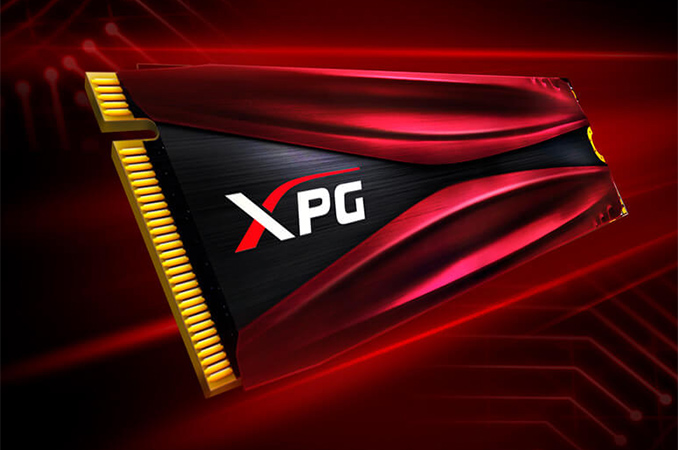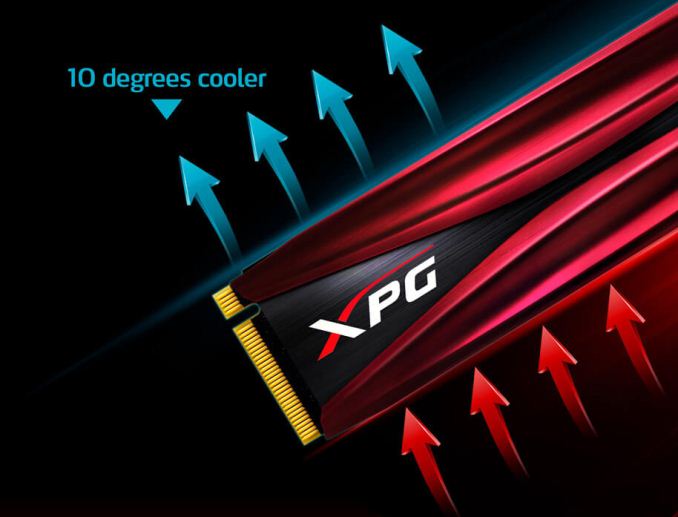ADATA Announces XPG Gammix S10: 3D TLC, SM2260, 1.7 GB/s Seq. Read, Radiator
by Anton Shilov on July 14, 2017 10:00 AM EST- Posted in
- SSDs
- Storage
- ADATA
- XPG
- Silicon Motion
- 3D NAND
- SM2260
- 3D TLC
- XPG SX7000
- XPG Gammix S10

ADATA this week launched yet another family of midrange SSDs aimed at gamers. The XPG Gammix S10 products are based on a well-known controller from Silicon Motion and resemble the company’s XPG SX7000 series announced in April. The new drives are equipped with a radiator to avoid performance throttling, and while using the M.2 form factor, will only fit into desktops as a consequence.
Over the past few quarters ADATA become one the largest independent vendors of 3D NAND-based SSDs due to the fact that it has managed to secure supply of 3D TLC and 3D MLC NAND flash from Micron. So far, the company has introduced multiple 3D NAND-based SSDs, including drives with SATA and PCIe/NVMe interfaces featuring different controllers from Silicon Motion and Maxiotek. The ADATA XPG SX7000-series drives powered by the SMI SM2260 controller and Micron’s 3D TLC NAND are among of the company’s recently launched drives aimed at performance mainstream PCs. As it appears, in the near future such SSDs will be joined by the new XPG Gammix S10 family, which use the same controller and 3D TLC NAND memory from Micron, but are equipped with a radiator to ensure lack of overheating and consistent performance. ADATA is not commenting on whether the XPG SX7000 and the XPG Gammix S10 are essentially the same SSDs, but they have exactly the same performance numbers and even their model numbers look similar (ASX7000NP-512GT-C => ASX7000NPC-512GT-C).
Speaking of performance, we know a lot what to expect from the SMI SM2260 in general and from the ADATA XPG SX7000/Gammix S10 in particular. As mentioned in the initial XPG SX7000 coverage, the drives are very different from each other due to the level of parallelism afforded by the controller/NAND combinations. The 512 GB models are rated for sequential read speeds up to 1750 MB/s, while sequential writes can reach up to 860 MB/s when pseudo-SLC caching is used. As for random performance, the 512 GB drive can offer up to 130K/140K 4 KB read/write IOPS. When it comes to the XPG SX7000/XPG Gammix S10 128 GB, the lowest capacity of the set, we are dealing with a drive capable of up to 660/450 MB/s sequential read/write performance as well as 35K/95K read/write IOPS.
This drive is slightly faster than SATA SSDs based on TLC NAND, but it should offer higher endurance because 3D TLC NAND is made using larger process technologies and can account for voltage drift better. Keep in mind that the XPG Gammix S10 are equipped with a radiator and therefore their performance under load may be slightly higher when compared to the predecessor. In the meantime, the XPG Gammix S10 will hardly fit into laptops because of its dimensions.
Meanwhile when it comes to endurance ratings, the ADATA XPG SX7000 and the XPG Gammix S10 are, again, exactly the same: the 128 GB SSD is rated for 80 TBW, the 512 GB version is capable of 320 TBW and the 1 TB model can handle 640 TBW (equals to around 0.3 DWPD (drive writes per day) across the warranty lifetime). Both SSD series come with a five-year limited warranty and are rated for 2 million hours MTBF.
| ADATA XPG Gammix S10 Specifications | ||||
| Capacity | 128 GB | 256 GB | 512 GB | 1 TB |
| Model Number | ASX7000NPC- 128GT-C |
ASX7000NPC- 256GT-C |
ASX7000NPC- 512GT-C |
ASX7000NPC- 1TT-C |
| Controller | Silicon Motion SM2260 | |||
| NAND Flash | 3D TLC NAND | |||
| Form-Factor, Interface | M.2-2280, PCIe 3.0 x4, NVMe 1.2 | |||
| Sequential Read | 660 MB/s | 1370 MB/s | 1750 MB/s | |
| Sequential Write | 450 MB/s | 820 MB/s | 860 MB/s | 850 MB/s |
| Random Read IOPS | 35K IOPS | 70K IOPS | 130K IOPS | |
| Random Write IOPS | 95K IOPS | 130K IOPS | 140K IOPS | |
| Pseudo-SLC Caching | Supported | |||
| DRAM Buffer | Yes, capacity unknown | |||
| TCG Opal Encryption | No | |||
| Power Management | DevSleep, Slumber | |||
| Warranty | 5 years | |||
| MTBF | 2,000,000 hours | |||
| MSRP | Unknown | Unknown | Unknown | Unknown |
ADATA did not announce MSRPs for the XPG Gammix S10 SSDs, but since the new drives are essentially the XPG SX7000 products equipped with radiators, do not expect their actual prices to be significantly different.
Related Reading:
Source: ADATA











9 Comments
View All Comments
DanNeely - Friday, July 14, 2017 - link
WTH did tacky heatsinks get promoted to radiators?No. It's not a radiator unless it's in a water loop.
thetuna - Friday, July 14, 2017 - link
Ehh, I mean, passive heat sinks are still radiators.BurntMyBacon - Monday, July 17, 2017 - link
Radiatora: any of various devices (such as a series of pipes or tubes) for transferring heat from a fluid within to an area or object outside
https://www.merriam-webster.com/dictionary/radiato...
I suppose you could make a case for heat-pipes, but these heat-spreaders have no fluid from which to transfer heat and do not match the definition presented.
willis936 - Friday, July 14, 2017 - link
Well that's just wrong.iwod - Friday, July 14, 2017 - link
I have been thinking about this for quite some time, It will be interesting when Anandtech does a comparison between Optane and the best of SSD. But given some preliminary data, and other testing of RAM Disk, it seems we are now bottlenecked by the Single Thread CPU performance. Or CPU Clock Speed. Since clock speed ceiling is pretty much set with TDP and unless we change to another material, we are going to get ~4Ghz only.bigboxes - Friday, July 14, 2017 - link
Exactly what CPU are you running? My Haswell is clocked at 4.6 24/7. I would assume the latest Intel Core i7-7740X can do 5Ghz without a lot of trouble.BurntMyBacon - Monday, July 17, 2017 - link
I think he was talking a rough estimate of stock clocks as 5GHz is not new territory to overclockers. Though, it does come at the expense of more TDP and less processor life. I think you missed his point, though. He's suggesting that these drives are limited by single threaded performance and we are quickly approaching the limit of what we can obtain on silicon. This may or may not be true, but Intel has given us no reason to believe otherwise. Clock speeds haven't increased all that much since the P4 era which took us from an initial maximum clock speed of 1.5GHz (stock) to 3.8GHz (stock) / 5GHz (OC). Afterwards, IPCs moved up pretty steadily until Sandybridge. Since then, we've had a slow down in generational IPC improvement.BurntMyBacon - Monday, July 17, 2017 - link
@iwod: "But given some preliminary data, and other testing of RAM Disk, it seems we are now bottlenecked by the Single Thread CPU performance. Or CPU Clock Speed. "If storage performance is in fact be Single Threaded performance limited under the current data transfer model, then we should start thinking about how to parallelize the workload. Flash based storage devices are using parallelism to obtain their throughput numbers to begin with. There is no reason to believe that this parallelism can not be extended to the processing elements. Flash devices already use controllers with multiple cores. It is conceivable that if a single CPU core isn't fast enough to issue commands, then multiple CPU cores could issue commands directly to individual controller cores. Think a CPU core per Controller core per flash module. This would take a rework of the current storage model, though.
However, I suspect that there are less disruptive solutions and I'm not entirely convinced that single threaded CPU performance is the limitation. In straight read scenarios it is entirely possible to saturate a 4xPCIe 3.0 bus with the fastest SSDs. Random read/write performance seems to be limited by the controller and flash itself. Intel's consumer Optane SSD only uses a 2xPCIe 3.0 bus and the Optane SSD DC P4800X doesn't quite max out its 4xPCIe 3.0 bus, though it does hit its max throughput at lower queue depths than traditional SSDs. In any case, the biggest advantage to Optane is the latency improvements.
Mikewind Dale - Thursday, July 20, 2017 - link
While we've obviously hit a wall with CPU clock speeds, I don't think that means we've hit a wall with CPU performance. For example: I have two laptops, a 3 year old quad-core 2.5-3.5 GHz AMD A10-5750M and a brand new dual-core 2.9-3.5 GHz Core i7-7500U.They basically have the same clock speed, but the AMD has double the cores. However, in a variety of benchmarks, I have found that the Intel gets about 1.5 to 2 times the performance - both single- and multi-threaded - than the AMD.
So that means that with the same clock speed, over a 3 year period, Intel has managed to get double the performance with half the cores, simply with greater efficiency. (Granted, I'm comparing two different architectures, but it's what I've got.)
Of course, this is hardly the same as we used to get. When I was a child, we were getting a doubling of clock speed every 18 months. My first computer was a 266 MHz Pentium II, and about 3 years later, the 1 GHz Pentium III was released.
So we're not getting those kinds of huge leaps in performance from pure clock speed anymore. But Intel and AMD are still obviously managing to find ways to achieve quite sizable gains from efficiency instead.